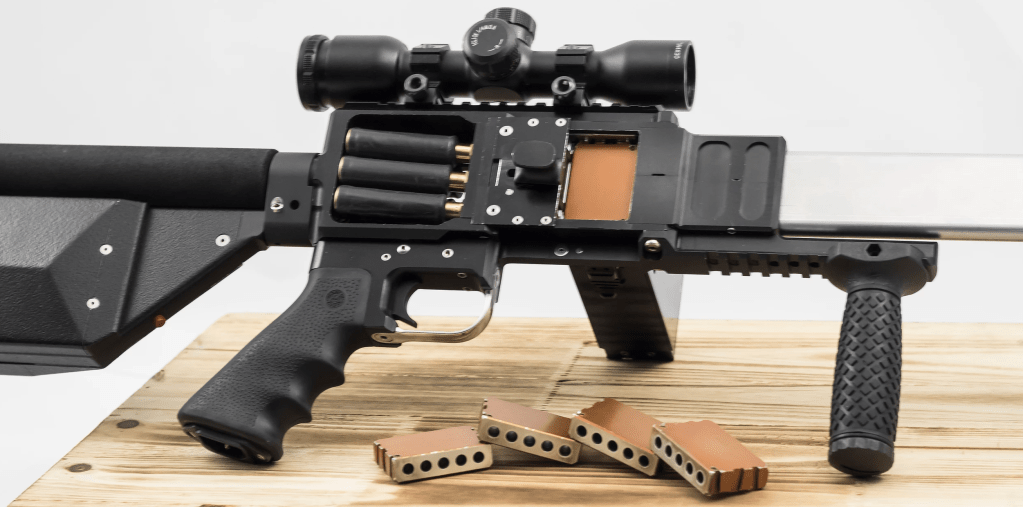

The L5 Ribbon Gun is a prototype firearm that you may or may not have heard of, but is the cause of a lot of excitement among firearms enthusiasts. Most firearms with a single barrel can shoot semi-automatic or three-round burst. Some can fire fully automatic.
The ribbon gun, officially called the L5 from Future Defense Munitions, can do those things but can also fire multiple rounds at the same time.
This weapon is a caseless multi-bore rifle that uses packets of five rounds instead of single cartridges, and these packets (called charge blocks) are loaded into a magazine for use in the weapon. The packets come in blocks and those blocks act as the weapon’s chamber – or chambers.
And instead of using a percussive round to fire the projectile, it uses an electric trigger to fire a round. This has the added benefit of axing the mechanical movement of pulling the trigger. When the round fires from the rifle, it’s still spinning, which gives it the same flight stabilization of a regular rifle. The rounds are 6mm, lighter than 7.62 ammunition but heavier than NATO 5.56 and don’t affect each other in-flight – they even shoot overlapping groups.

Before we get into the issues around using an electric charge to fire rounds in a war zone, know the Ribbon Gun can fire 15,000 rounds on just one battery. It’s not going to be a drain on military resources and since it loads in stacks, it means fewer reloads in shorter time.
The best part about the L5 Ribbon Gun in potential military use is not just raiding a house and unloading five rounds into an enemy, it’s that an effective rate of fire’s biggest obstacle is heat buildup. In the L5, the heat is expended from the rifle along with the charge blocks.
An M16 firing 10 rounds per minute will heat up to around 600 degrees fahrenheit. It will reach a thousand degrees firing up to 120 rounds per minute. The L5 Ribbon Gun maxes out at around 400 degrees, giving it a more effective rate of fire.
Even more importantly for troops in combat, the L5 and its previous iterations won’t jam. The packet system that removes much of the heat from the weapon also reduces the amount of movement and machinery involved in firing rounds and ejecting magazines or blocks. The more simple firing mechanism, the fewer chances there will be for a catastrophic jam at the wrong time, right?

It’s more than that. There are no spring-loaded magazines to mess around with; the issues that getting a weapon dirty can cause are practically eliminated with the Ribbon Gun. So far, this may sound like an advertisement for the weapon, but there are downsides as well (despite how hard the inventor tried to account for every AR family shortcoming).
The charge blocks themselves will need to be dirt-proof, but do they need to be waterproof? It’s unclear what external factors could affect the weapon firing. What’s more is that it may work in the dry heat of the desert, but that doesn’t mean it would work in colder, damp climates.
It’s also a sure bet that many troops, especially special operations forces, are going to want to attach some special features to their weapons. Lights and night vision aiming are just a couple of items some American forces are going to ask for. Then there’s the Chesty Puller question: where do you put the bayonet?
The United States military has been testing ribbon guns in some form or another since 2018, and it must have seen the benefits of a lighter weight weapon and ammo designed to address the shortcomings of the current standard issue rifle.
Featured image: L5 prototype, courtesy FD Munitions.
